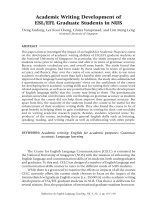Chinese military development
Bạn đang xem bản rút gọn của tài liệu. Xem và tải ngay bản đầy đủ của tài liệu tại đây (200.23 KB, 3 trang )
Last year's annual report on Chinese military developments was widely criticized. What does the 2013
version offer?
After a year-long hiatus, the U.S. Department of Defense (DoD)’s annual report on Chinese military developments
is back and better than ever. Its 43-page 2012 predecessor was widely criticized for arriving far later than Congress
requested and containing little substance or new data. But this year’s expeditiously-issued 92-page document continues
a tradition of detailed, sophisticated, publicly-available U.S. government analysis previously seen in the 2011 DoD
report, the 2010 National Air and Space Intelligence Center (NASIC) report on China’s air force, and the 2009 and 2007
Office of Naval Intelligence (ONI) reports on China’s navy.
Like these other landmark reports, this year’s DoD iteration clearly and understandably comes from a U.S. military
perspective, yet strives to provide a comprehensive picture of Chinese military developments and the strategic
concerns that motivate them. This represents an admirable effort to offer a balanced assessment, as can be seen in
remarks at the time of its release by David F. Helvey, deputy assistant secretary of defense for East Asia. Useful data
are presented on everything from Chinese sea- and -land based energy access to apparent ambiguities in Beijing’s “no
first use” nuclear doctrine to members of the Central Military Commission and their key professional relationships.
All this context matters deeply, and should be commended. But arguably the report’s greatest contribution lies in more
specific areas: providing authoritative assessments of key People’s Liberation Army (PLA) developments that are
difficult, if not impossible, to achieve or confirm via other publicly-available sources, such as Beijing’s own recentlyreleased 2013 Defense White Paper—which, like many Chinese public strategic documents, offers few specifics. Chinese
government representatives are already out in force criticizing this year’s DoD report and claiming that its content is
distorted or inaccurate, but as usualdo not offer credible evidence to clarify or counter even the report’s most important
assertions. Yet it is precisely in such areas—which include hard-to-attribute cyber activities and other types of
espionage—that observers of China’s military development need the greatest governmental assistance. After all, as a
recentWall Street Journal op-ed argues cogently: “In the long run Beijing usually does what it says it is going to do,
although the execution may be concealed with deception.”
With respect to obfuscation, the report documents that China has conducted multiple naval operations in the
undisputed U.S. Exclusive Economic Zones (EEZs) of a nature that it would oppose a foreign military such as that of the
U.S. conducting in its own claimed EEZ—which it is projected to fill with increasing numbers of maritime law
enforcement vessels. While the report states that China is conducting such activities in the EEZs of multiple states, a
reference that almost certainly includes Japan, it is worth noting the report’s exact wording with respect to the United
States: “the United States has observed over the past year several instances of Chinese naval activities in the EEZ
around Guam and Hawaii. One of those instances was during the execution of the annual Rim of the Pacific (RIMPAC)
exercise in July/August 2012. While the United States considers the PLA Navy activities in its EEZ to be lawful, the
activity undercuts China’s decades-old position that similar foreign military activities in China’s EEZ are unlawful.” It will
be particularly interesting to see how Beijing responds to such revelations, which further underscore the emerging
contradictions between China’s promotion of restrictive approaches vis-à-vis foreign military and governmental
activities in the Near Seas (Yellow, East, and South China Seas) even as it pursues increasing access to such other
strategic seas as the Western Pacific and the Arctic. Given this complexity, perhaps Beijing’s approach for now will be to
denounce the report generally while avoiding this specific issue
Breaking Down Australia’s Defense White Paper 2013
OCEANIA REGION
SECURITY
TOPIC
AUSTRALIA
In an increasingly contested Asia, with China rising and America rebalancing, middle powers are struggling to
redefine their defense strategies. One such player, Australia, has now done so in a way that seeks to reconcile its
extensive national interests with a close U.S. alliance, a web of new Asian security partners and a relationship of mutual
respect with China.
It almost succeeds, but stumbles on a critical factor – money. The current Australian Labor government is
underspending on defense and so far the conservative opposition – likely to win power in an election due this
September – is not promising much more.
Four years ago, the then Australian prime minister Kevin Rudd launched a defense white paper amid furious concern
about China’s destabilizing rise. A much stronger Australian Defence Force was promised with new-generation
submarines, cruise missiles, and joint strike fighters. This blunt document and its unusually clumsy diplomatic handling
added to a drumbeat of political mistrust between Australia and its largest customer.
But a lack of credible budgeting undermined this vision of projected Australian firepower, and Canberra was caught
committing the cardinal sin of statecraft: speaking loudly whilst carrying a small stick, the opposite of Teddy Roosevelt’s
dictum.
With a quite different defense white paper launched last Friday, successor Prime Minister Julia Gillard treads a notably
more cautious line, declaring that Australia "does not approach China as an adversary." China is listed this time as a
military partner, complete with bilateral exercises, confidence-building dialogue and even an Australia-China Military
Culture and Friendship week.
The document builds on Ms. Gillard’s optimistic narrative of a prosperous ‘Asian Century’. It offers some even-handed
and sophisticated appraisals of U.S.-China relations, and some acknowledgement of the need to watch for and manage
risk, but does not fully convey how the Asian strategic environment is deteriorating and the possibilities of conflict
rising.
So whereas the Chinese saw the Rudd plan as a red rag, it is tempting to caricature Australia’s new strategy as raising a
white flag.
That is certainly not fair: alliance commitments still feature fundamentally in Canberra’s military strategy. The white
paper says Australia will uphold a rules based-order, is prepared "to conduct conventional combat operations to counter
aggression or coercion against our partners," and commits to buying electronic warfare aircraft that could help in such a
contingency.
It also confirms steps to use Australian territory in support of the Obama Administration’s Asia pivot, beyond the
presence of Marines in Darwin. Notably, airfields in northern Australia and the Cocos Islands in the Indian Ocean will be
upgraded. This needs to be done for Australia aircraft anyway, notably the new P-8A Poseidon fleet currently being
acquired, but will open the way to their possible future use by the U.S. military.
Notably, the white paper rejects the idea, advanced by prominent scholar and former official Hugh White,that Australia
will somehow have to choose between the United States and China, and emphasizes the likelihood that those powers
will succeed in avoiding major conflict.
The white paper also redraws the map of Australian security in a way that may not appeal to Beijing. It makes Australia
the first country officially to define its region of strategic interest as the Indo-Pacific. This in itself is not an anti-China
move, since the Indo-Pacific is above all an objective description of the super-region in which China is rising, given its
large economic, energy and diplomatic equities across the Indian Ocean. And it is a natural fit with Australia’s twoocean geography and the increasing attention being paid to resources development and military infrastructure in the
country’s sparsely-populated north and west.
ASEAN chiefs work closely on security issues
ASEAN defence ministers yesterday reaffirmed their commitment to work closely to address emerging security
challenges, such as cyber security, potential communicable diseases and climate change.—Photo vov
BANDAR SERI BEGAWAN (VNS)— ASEAN defence ministers yesterday reaffirmed their
commitment to work closely to address emerging security challenges, such as cyber
security, potential communicable diseases and climate change.
A press statement, issued yesterday following the 7th ASEAN Defence Ministers' Meeting
(ADMM) in Brunei, said ASEAN fully supported the inaugural ADMM-PLUS Humanitarian
Assistance and Disaster Relief and Military Medicine Exercise to be held in Brunei as
landmark co-operation among the defence forces of the ADMM-PLUS members states.
ASEAN defence chiefs also adopted four concept papers namely:
- Establishing ASEAN defense interaction programmes
- The establishment of logistics support framework
- The establishment of the ADMM-PLUS experts' working group on humanitarian mine
action
- The transition of the ADMM-PLUS experts' working group co-chairmanship In the Joint
Declaration of the ASEAN Defence Ministers, they reaffirmed their commitment to fully and
effectively implement the Declaration on the Conduct of Parties in the East Sea.
A Vietnamese delegation led by Minister of National Defence Phung Quang Thanh
attended the meeting.
He said ASEAN needed to strengthen solidarity and co-operation for common prosperity,
focusing on co-operation with China and the US, the two biggest economic powers in the
world, which had influence on regional security.
He also reaffirmed Viet Nam's stand of resolving disputes by peaceful measures,
respecting international laws.
The defence ministers also expressed support for their "leaders' commitment at the 22nd
ASEAN Summit for ASEAN to work actively with China towards the early conclusion of a
code of conduct (COC) in the East Sea to promote peace and stability".
The theme of the 7th ADMM is "Securing Our People, Our Future Together".
The ADMM is the highest defence mechanism in ASEAN which provides a platform for
strategic dialogue and practical co-operation. It aims to promote mutual trust and
confidence through greater understanding of defence and security challenges as well as
enhancement of transparency and openness.
ASEAN groups Indonesia, Malaysia, the Philippines, Singapore, Thailand , Brunei, Myanmar, Cambodia,
Laos and Viet Nam.— Agencies
Le van qui l8 b1
Trinh van binh L23
Le tuan anh
Pham tuan Anh s









